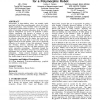Free Online Productivity Tools
i2Speak
i2Symbol
i2OCR
iTex2Img
iWeb2Print
iWeb2Shot
i2Type
iPdf2Split
iPdf2Merge
i2Bopomofo
i2Arabic
i2Style
i2Image
i2PDF
iLatex2Rtf
Sci2ools
HRI
2006
ACM
2006
ACM
Changing shape: improving situation awareness for a polymorphic robot
Polymorphic, or shape-shifting, robots can normally tackle more types of tasks than non-polymorphic robots due to their flexible morphology. Their versatility adds to the challenge of designing a human interface, however. To investigate the utility of providing awareness information about the robot’s physical configuration (or “pose”), we performed a withinsubjects experiment with presence or absence of pose information being the independent variable. We found that participants were more likely to tip the robot or have it ride up on obstacles when they used the display that lacked pose information and also more likely to move the robot to the highest position to become oriented. There was no significant difference in the number of times that participants bumped into obstacles, however, indicating that having more awareness of the robot’s state does not affect awareness of the robots’ immediate surroundings. Participants thought the display with pose information was easier to...
| Added | 13 Jun 2010 |
| Updated | 13 Jun 2010 |
| Type | Conference |
| Year | 2006 |
| Where | HRI |
| Authors | Jill L. Drury, Holly A. Yanco, Whitney Howell, Brian Minten, Jennifer Casper |
Comments (0)

